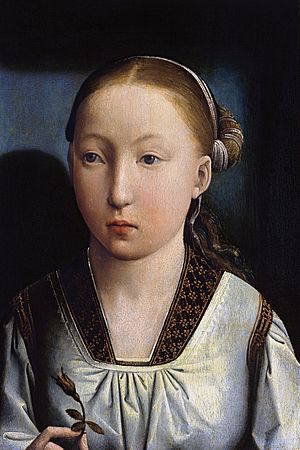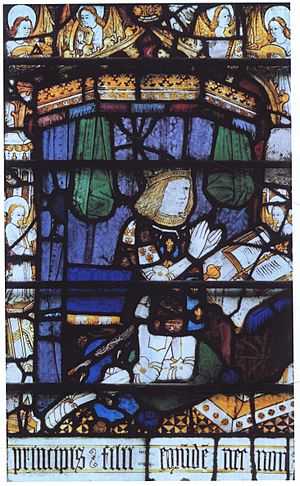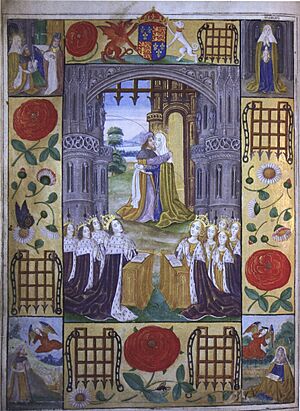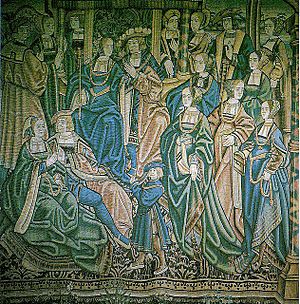Arthur, Prince of Wales facts for kids
Quick facts for kids Arthur |
|
|---|---|
| Prince of Wales | |

Portrait, c. 1500
|
|
| Born | 19/20 September 1486 Winchester Cathedral Priory, Winchester, Kingdom of England |
| Died | 2 April 1502 (aged 15) Ludlow Castle, Ludlow, Shropshire, Kingdom of England |
| Burial | 25 April 1502 Worcester Cathedral, Worcester |
| Spouse | |
| House | Tudor |
| Father | Henry VII of England |
| Mother | Elizabeth of York |
| Religion | Roman Catholicism |
Arthur, Prince of Wales (born 19/20 September 1486 – died 2 April 1502), was the oldest son of King Henry VII of England and Elizabeth of York. He was also the older brother of the future King Henry VIII.
From the moment he was born, Arthur was the heir apparent, meaning he was next in line to become king. People at the time saw him as a great hope for the new Tudor royal family. His mother, Elizabeth, was the daughter of King Edward IV. Arthur's birth helped bring together the two powerful families, the House of Lancaster and the House of York, ending a long period of wars.
Plans for Arthur's marriage started when he was very young. At age eleven, he was officially promised to Catherine of Aragon. She was a daughter of the powerful rulers of Spain, Isabella I and Ferdinand II. This marriage was meant to create an alliance between England and Spain against France.
Arthur was well-educated and healthy for most of his life. After marrying Catherine in 1501, they moved to Ludlow Castle in Shropshire. Six months later, Arthur died there, possibly from a serious illness called the sweating sickness. Catherine survived the illness.
One year after Arthur's death, King Henry VII wanted to keep the alliance with Spain. He arranged for Catherine to marry Arthur's younger brother, Henry. Henry later became King Henry VIII in 1509.
Contents
Arthur's Early Life
Henry VII became King of England after winning the Battle of Bosworth Field in 1485. To make his Tudor family's claim to the throne stronger, Henry decided to name his first son "Arthur." He also wanted him born in Winchester, where the legend of King Arthur began. This was to show the Welsh roots of the Tudors.
Arthur was born at Saint Swithun's Priory on the night of 19/20 September 1486. He was Henry and Elizabeth's first child. People at the time were very excited about his birth. They saw him as a symbol of peace after the long Wars of the Roses.
Arthur became Duke of Cornwall when he was born. Four days later, he was baptized at Winchester Cathedral. Important people like John de Vere, 13th Earl of Oxford and his grandmother, Queen Elizabeth Woodville, were his godparents.
Growing Up and Learning
On 29 November 1489, Arthur was made a Knight of the Bath. He was then given the titles of Prince of Wales and Earl of Chester. He had a special ceremony at the Palace of Westminster on 27 February 1490.
In May 1491, he became a Knight of the Garter at Saint George's Chapel at Windsor Palace. Around this time, Arthur started his formal education. His teachers included John Rede, Bernard André, and Thomas Linacre.
Arthur's studies covered many subjects. He learned grammar, poetry, rhetoric (the art of speaking well), and ethics (moral principles). He also focused a lot on history.
Arthur was a very good student. He read many important works from famous writers like Homer, Virgil, and Cicero. He also studied history books by Thucydides, Caesar, and Livy. Besides academics, Arthur was a "superb archer" and learned to dance well.
Arthur's Personality and Health
Some people used to think Arthur was often sick, but this isn't true. There are no reports of him being ill during his life. Arthur grew up to be taller than most people his age. The Spanish court thought he was handsome. He had reddish hair, small eyes, and a high-bridged nose. He looked a lot like his younger brother Henry.
Historians describe Arthur as having a "friendly and gentle" personality. He was seen as a "delicate lad" overall.
His Role in Government
In May 1490, Arthur was made Lord Warden of the Marches. This meant he was in charge of the border areas near Scotland. From 1491, he was also part of "peace commissions."
In October 1492, when his father went to France, Arthur was named Keeper of England. This meant he was in charge of the country. King Henry VII also set up the Council of Wales and the Marches for Arthur in Wales. This council helped the king control Wales. Arthur was sent to Wales in 1501 when he was fifteen.
Arthur had many young noblemen serving him. These included sons of important English, Irish, and Welsh families. He grew up with Gruffydd ap Rhys ap Thomas, the son of a powerful Welsh nobleman. Gruffydd became very close to Arthur.
Arthur's Marriage to Catherine

King Henry VII wanted Arthur to marry a daughter of the powerful Spanish rulers, Isabella I of Castile and Ferdinand II of Aragon. This marriage would create an alliance between England and Spain against France. They decided that Catherine, the youngest Spanish princess, would be a good match.
The Treaty of Medina del Campo was signed in 1489. It stated that Arthur and Catherine would marry when they were old enough. Catherine's dowry (money or property she brought to the marriage) was set at 200,000 crowns.
Since Arthur was not yet 14, a special permission from the Pope was needed. This was granted in February 1497. They were officially engaged by proxy (meaning someone stood in for Catherine) on 25 August 1497. Two years later, another proxy marriage happened at Arthur's home in Bewdley. Arthur said he was "much rejoiced to contract the marriage because of his deep and sincere love for the Princess."
The young couple wrote letters to each other in Latin. On 20 September 1501, Arthur turned 15, which meant he was old enough to marry. Catherine arrived in England about two weeks later, on 2 October 1501.
They met for the first time on 4 November 1501 in Hampshire. Arthur wrote to Catherine's parents that he would be "a true and loving husband." However, they soon found out they spoke Latin with different accents, so it was hard for them to talk easily. Five days later, Catherine arrived in London.
The wedding ceremony finally took place on 14 November 1501 at Saint Paul's Cathedral. Both Arthur and Catherine wore white satin. After the ceremony, they went to Baynard's Castle for celebrations.
Arthur's Death

After their wedding, Arthur and Catherine lived at Ludlow Castle in the Welsh Marches. Arthur had been getting weaker since his wedding. In March 1502, both Arthur and Catherine became sick with an unknown illness. Some historians think it was the mysterious English sweating sickness, tuberculosis, plague, or influenza. Catherine recovered, but Arthur died on 2 April 1502 at Ludlow. He was just six months short of his sixteenth birthday.
News of Arthur's death reached King Henry VII's court on 4 April. The King was very sad and cried. His wife, Queen Elizabeth, tried to comfort him. She reminded him that God had helped him become king and that they still had other children.
On 8 April, a special prayer service was held for Arthur's soul. His body was taken from Ludlow Castle to the Parish Church of Ludlow on 23 April. On 25 April, Arthur's body was taken to Worcester Cathedral by boat and then by a special wagon. Catherine did not attend the funeral, as was the custom for wives at that time. Arthur was buried at Worcester Cathedral.
Arthur's Legacy
Soon after Arthur's death, the idea came up for Catherine to marry Arthur's younger brother, Henry. King Henry VII and Queen Isabella of Spain wanted this marriage to happen, and the Pope gave permission.
Henry VIII became king on 22 April 1509 and married Catherine on 11 June. They had six children, but only one, Mary I, survived to adulthood. Later, King Henry VIII wanted to end his marriage to Catherine. He was worried about not having a male heir and believed his marriage was wrong.
Henry VIII ended his marriage to Catherine in 1533. He then married Anne Boleyn. Anne was later executed, and Henry went on to marry four more times. When he died in 1547, he had three living children. His only son, Edward VI, became king but died six years later. Henry's daughters, Mary I and Elizabeth I, then became queens. When Elizabeth I died in 1603, the House of Tudor royal family ended.
Even though Arthur played an important role in English history, he has largely been forgotten since his death. In 2002, a special service was held at Worcester Cathedral to remember him 500 years after his death.
Images for kids
-
1496 Portrait by Juan de Flandes thought to be of 11-year-old Catherine. She resembles her sister Joanna of Castile.
-
Prince Arthur, depicted on a stained glass window at Great Malvern.
See also
 In Spanish: Arturo Tudor para niños
In Spanish: Arturo Tudor para niños








